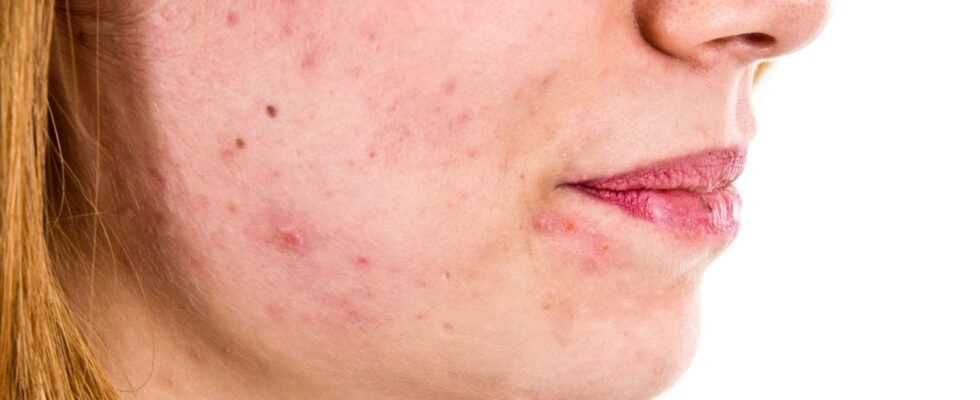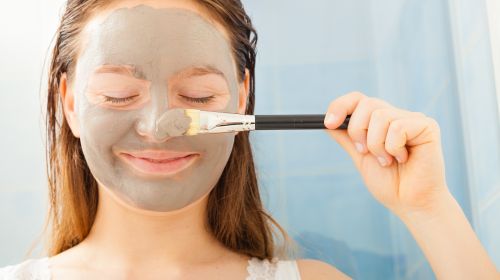Acne, medically Acne vulgaris, is the most common skin disease worldwide. Between 60 and 80 percent of all adolescents suffer from impure skin in different forms. But adults are also affected by so-called late acne. Typical for acne are blackheads, purulent pimples and inflamed nodules – how it happens and what helps.
- Adolescents and young adults most often have acne vulgaris.
- © iStock.com/energyy
Behind acne is a disease of the sebaceous gland follicles, which, depending on the severity, manifests itself in pimples or blackheads (comedones). These blemishes mainly occur on parts of the body that have a relatively large number of sebaceous glands. Impurities accumulate on the face, décolleté, neck, back or on the upper arms.
Acne usually regresses after puberty, with five to seven percent of those affected having permanent scars. About ten percent of those affected still struggle with symptoms of late acne after the age of 25, women more often than men. However, slightly more boys than girls suffer from blemishes in teenage years and severe cases are more common in male adolescents.
Forms of acne
Acne usually refers to common acne. In addition, there are a number of other forms of acne that differ in their causes and signs from ordinary acne vulgaris:
In the Acne inversa the hair follicles in the armpit and pubic hair become inflamed and cause painful knots.
Acne venenata or contact acne: This form of acne occurs when the skin frequently comes into contact with certain chemical substances (such as chlorinated hydrocarbons, tar or mineral oils and lubricants).
The Newborn acne (Acne neonatorum, Baby acne, infant acne) occurs in the first weeks of life and is often a reaction to hormonal changes after birth. Fluctuations in hormone levels during pregnancy also play a role.
Who under Mallorca acne suffers from hypersensitivity to a combination of sunscreen and UV radiation.
Late acne or acne tarda usually occurs in adults after the age of 25 to 30.
Four foods for beautiful skin
TargetVideo
Causes: How does acne develop?
Acne vulgaris usually arises from a combination of several triggering factors. This includes:
- Overactive sebaceous glands
- Cornification disorder in the sebaceous gland duct
- Inflammatory reaction
- Overgrowth of bacteria
Hormones play an important role in all of these processes. Due to the hornification and blockage of the sebum glands, the sebum can no longer drain properly, blackheads form. These can be colonized by bacteria and ignite.
Pimples: 3 home remedies for blackheads
TargetVideo
The hormones are changing
If the hormonal balance changes, it is possible that acne is triggered. The main focus here is on fluctuations in the release of androgens (male sex hormones). The sebaceous glands on which the inflammatory pimples form have androgen receptors. They react to the sex hormones with an increased sebum production. The body releases a lot of hormones during puberty, which is why teenagers fight acne. Scientists assume that heredity also plays a role in the development of acne. For example, overproduction of androgens during puberty can be genetic.
The main causes of pimples in adults
stress: Mental stress – such as anger with the boss, partner or the double burden of job and family – do not leave the skin untouched. The reason: Due to the hectic pace and tension, the body produces more stress hormones and testosterone. Both messenger substances stimulate the skin to produce more sebum. If you are constantly under current, you can try relaxation techniques or sports to clear your head and do something good for the skin and the rest of the body.
Wrong care: Rich cream or anti-aging care can be too much for skin prone to blemishes. The right care for combination skin provides moisture without weighing it down or closing the pores. Anyone who thinks that late acne can be managed with frequent cleaning or aggressive washing gels is wrong. On the contrary, over-care of the skin can increase sebum production and therefore pimples.
Sun acne with chemical UV filters can also make late acne worse. These are sunscreens that take a soak. Physical, immediately effective filters, on the other hand, have a rather positive effect on the complexion.
nutrition: What we eat is very important for our skin. Studies indicate that fatty foods such as sausages and chips or sweets such as chocolate and other foods with a high glycemic index make the facial skin bloom. The same applies to dairy products. Those with late acne should therefore switch to chocolate with a high cocoa content and avoid whole milk chocolate.
Hormonal change: Even if women are menopause: hair loss and dry skin are possible, the pill is stopped or the menstrual cycle is close to menstruation, pimples can spread to the face and décolleté. Accordingly, pregnancy can also lead to blemished skin.
Antibiotics: Anyone who is prescribed one of the highly effective medications for a bacterial disease messes up the intestinal flora – and thus possibly the skin, which can also be more sensitive to the UV radiation from the sun thanks to an antibiotic. Many people who take antibiotics more often complain of pustules and pimples as a side effect.
Symptoms of acne vulgaris
Those affected by acne show symptoms of blackheads, pustules, small fistulas and lumps in the skin depending on the severity. With severe acne, typical scars remain after healing.
Acne is particularly evident in areas where there are a particularly large number of sebaceous gland follicles – in other words on the face, neck, chest and back. Depending on the severity, blackheads first develop, which can later ignite due to the penetration of bacteria. The pimples are filled with pus, which can be seen in small blisters on the surface of the skin. This form is medically called acne papulopustulosa. On the basis of the acne symptoms, dermatologists can divide the skin disease into different degrees of severity.
Severity levels in acne
Mild acne: few blackheads (comedones) and few pimples
Moderate severity: many comedones, few to many pimples and few small nodules or cysts. In contrast to mild acne, the moderate severity causes inflammation.
Severe acne: In addition to the blackheads, there are a lot of pimples, small cysts and possibly also lumps, as well as painful inflammations that leave scars when they heal.
Very severe acne: The inflammatory pimples are very pronounced. With this form, there are always knots that reach deep into the skin.
The inflammatory pimples and lumps under the skin that occur with severe and very severe acne are painful and itchy. The lumps not only appear in the typical acne regions, but also on the arms, legs and buttocks. They often leave acne scars. This most severe form, the acne conglobata, affects mostly men, even in adulthood.
How Acne Vulgaris Is Diagnosed
To diagnose acne, the doctor first takes a medical history. In it he asks the time when the symptoms first appeared, their development and the previous treatment.
For an exact diagnosis, a dermatologist must determine the skin type in detail. In this way, the disease can be divided into degrees of severity on which the treatment is based. Depending on the form and development, further procedures may be necessary, such as a hormone test. This is necessary if, for example, severe acne suddenly occurs in women, the severity of the acne increases or the therapy fails. The dermatologist takes blood for the hormone examination.
Another procedure that specialists do not routinely recommend is a microbial test. In individual cases, this examination for bacteria serves to delimit other causes of the symptoms or to detect antibiotic-resistant germs.
When acne appears in adolescents, parents tend to dismiss this as a common symptom of puberty. A large part of the teenagers help with common means from the drugstore or pharmacy. However, between 15 and 30 percent of those affected need medical treatment due to the severity or persistence of the skin disease.
What helps against acne?
Treatment for acne depends on the severity and speed of development. Skin type, gender and age also play a role in acne therapy. The psychological suffering due to externally visible pimples and blackheads also influences the decision about which form of therapy to choose.
First of all, the treatment is about removing calluses, reducing any inflammation and, if necessary, reducing sebum production. If there is a social withdrawal due to the complexion of the skin and effects on self-esteem, a quick relief of the externally visible symptoms is particularly important.
Both external (topical) and medicinal (systemic) options are available for therapy. Both are often combined, with the main criteria for taking medication being severe forms of acne with scarring. Not every treatment leads to success. It is important to adjust the treatment under the guidance of the dermatologist if there is no successful therapy.
Remedies for acne: how do creams, ointments and solutions help?
A number of active substances can be used for the external therapy of acne vulgaris. Anticomedogenic and keratolytic substances are suitable for dissolving calluses and smoothing the skin surface. Anticomedogenic means that there are no substances that clog pores and thus lead to blackheads (comedones), while keratolytic active ingredients loosen horny cells from the upper layer of the skin and thus prevent the formation of blackheads.
Anticomedogenic and keratolytic substances used to treat acne include azelaic and salicylic acids, tretinoin and isotretinoin. Antimicrobial agents such as benzoyl peroxide, azelaic acid, zinc, disinfectants and external antibiotics are suitable to slow the further spread of inflammation and to minimize existing ones.
Medicines for acne vulgaris
If the course is persistent and severe, especially if there is scarring, antibiotics are used to treat acne: tetracyclines, clindamycins or trimethoprime inhibit the formation of bacteria. Because antibiotics can reduce the effectiveness of hormonal contraceptives such as birth control pills, it is advisable to use additional contraceptives such as condoms during treatment. The active ingredient isotretinoin constricts the sebum glands and reduces sebum production.
Antiandrogens or estrogens can be used in women. An excess of male sex hormones can contribute to the development of acne. Antiandrogens inhibit their production. The birth control pill helps many women as a remedy for acne. The hormone estrogen it contains has a visible impact on the complexion of many women. However, the birth control pill is not suitable for overweight and smoking women, as it increases the risk of thrombosis.
What helps with acne? Treatment tips
Pharmacies and drug stores offer effective treatments for acne for teenagers and adults. These tips can help those affected:
Gentle cleaning: Wash the skin twice a day with lukewarm water. Slightly acidic syndets (pH 5.5 or 6.5) are recommended. They create a milieu in which the bacteria are not viable, while the skin's protective acid mantle remains intact.
Facial steam baths or moist compresses widen the pores of the skin and are a gentle treatment for acne. Chamomile also relieves the inflammation.
Avoid fatty skin care products. You can make acne worse – this also applies to makeup. Products with ingredients such as petroleum jelly, lanolin or paraffin oil in particular can worsen the complexion. It is better to use special water-based care series that are tailored to blemished skin (consult the dermatologist). Makeup should be removed thoroughly every night before bed.
A balanced nutrition often has a positive effect on the skin condition. Smoking and alcohol, however, negative. If you notice that certain foods make your skin bloom, it's best to banish them from your menu. It has been proven that a diet with many dairy products and carbohydrates is unfavorable for acne. Vegetables and fruits should be on the menu, but little sugar.
Be careful with the sun! It does not always improve the complexion in acne. In about 30 percent of those affected, the complexion actually worsens. Special care should be taken if the doctor has prescribed antibiotics or vitamin A derivatives. Because this makes the skin more sensitive to light. A so-called Mallorca acne can even trigger sunlight.
Steer clear of the pimples! If you push it yourself, you risk that the inflammation spreads and scars occur. Pimples and blackheads should be removed by a trained beautician or at the dermatologist's office.
Home remedies for acne
There are also some well-known home remedies for acne.
Treat affected parts of the body up to three times a day with chamomile compresses. The medicinal plant soothes the skin and has an anti-inflammatory effect. Boil a tea from 250 ml of water and two bags of chamomile tea. Dip cotton pads in the tea and wait for them to cool down. Then put the compresses on affected areas of the body and leave on the skin for 15 minutes.
Mix up a mask made of healing earth. The healing earth absorbs the excess skin sebum. To do this, stir a paste of four tablespoons of healing earth and a little water. Apply the paste to areas of the body affected by acne and let them dry for 15 minutes. Then wash off the healing earth.
Another effective home remedy for pimples: Prepare a 20-minute steam bath with sage. The steam bath opens the pores, sage has an anti-inflammatory effect. To do this, put 40 grams of sage with a liter of hot water in a bowl. Then inhale the steam with a towel over your head. Alternatively, you can make the steam bath with thyme or rosemary.
Acne: course and stages
Acne is often over with puberty. Only in rare cases can it persist in adults over 30 to 40 years of age. Doctors then speak of persistent acne. The course is different in boys and girls. In men, the acne is often longer and severe forms of acne occur more often, which is partly due to the increased production of androgens.
Acne runs roughly in three stages:
First, comedones form. This is known as the non-inflammatory phase in the course of acne. Open blackheads can be identified by the black dot in the middle. This blackened area consists of melanin, which comes from the pigment-forming cells (melanocytes).
When a blackhead catches fire in the second phase, the typical pimples and pustules form. This is why we speak of an inflammatory phase.
In the third phase, the pimples disappear, and if the course is severe, scars can remain from the acne. Since these can be a cosmetic problem, some cosmetic studios now offer laser treatment to reduce scars.
The course of acne does not always follow these three stages. Some sufferers only develop blackheads.
How can you prevent acne?
The causes of acne are many. Mostly hormonal changes during puberty are the cause of the annoying pimples. The family disposition also plays a role. A targeted, safe prevention of acne is therefore not possible.
The right skin care helps to a certain extent to prevent acne pimples. For prevention, doctors generally recommend the use of cosmetic products that are not comedogenic. These are free of active ingredients that additionally clog the sebum glands and thus contribute to the formation of blackheads. Comedogen-free products are marked on the packaging accordingly and are easy to identify.
Although the influence of diet on the development of acne has not been adequately documented, there are many indications that it plays a role in acne prevention. Smoking and alcohol consumption also have a negative effect on the skin.


